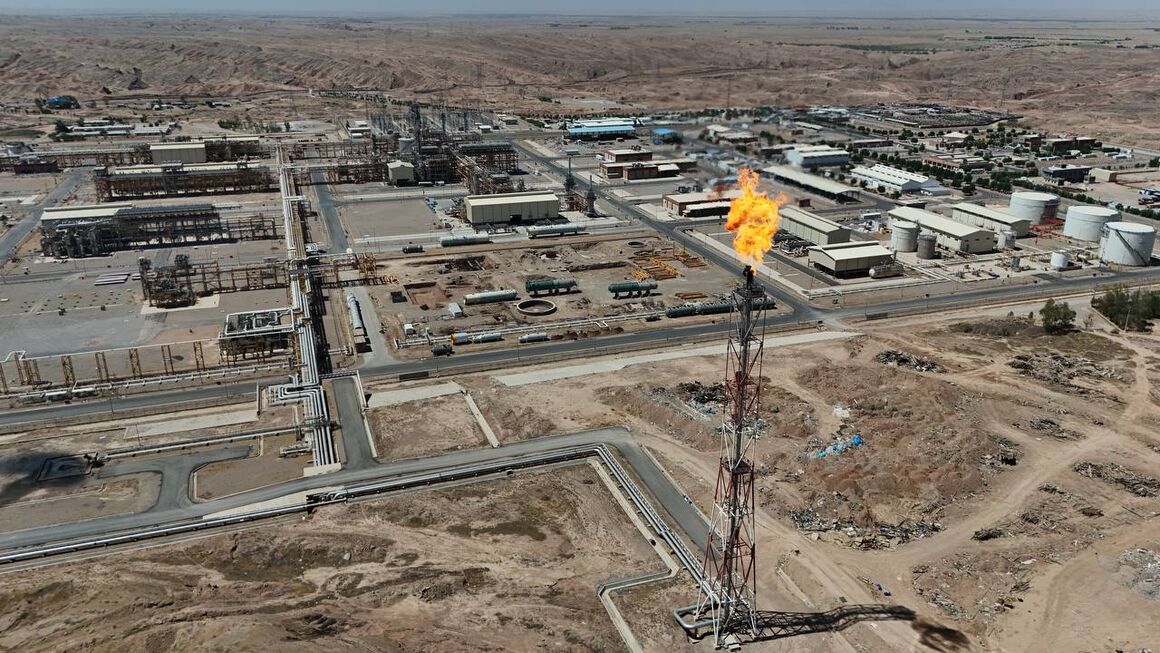In recent years, from Qeshm to Kharg, from Dehloran to Maroun, NGL projects have been launched. The gases that once burned are now being used as feedstock for petrochemical plants and exported. According to international agreements, Iran must reduce its greenhouse gas emissions by 2030. Now, with the JCPOA stalled and sanctions in place, the country must take matters into its own hands.
Globally, around 150 billion cubic meters of gas are burned annually in flares at oil wells, turning into pollutants—a figure equivalent to one-third of Europe’s total gas consumption, according to World Bank statistics. As of 2018, Iran ranked third after Russia and Iraq in gas flaring. However, flared gas in the country decreased from 17 billion cubic meters in 2018 to 13.78 billion in 2019.
85% domestic contribution in NGL 3100
Extinguishing flares is undeniably necessary, both economically and in terms of meeting global commitments. A successful example is the flare gas recovery project in the oilfields of southern Ilam province. With a final capacity of 240 million cubic feet per day (MMCFD), this project includes NGL 3100, three pressure boosting stations, a 100-megawatt power plant, and over 350 kilometers of pipelines. Initially, it began collecting 80 MMCFD, gradually expanding to full capacity.
Once operational, the project will inject over 150 MMCFD of light gas into the national gas grid, while heavier components will be sent via pipeline to NGL 3200 in West Karun and then to Bandar Imam Petrochemical Plant. After the Dehloran Petrochemical Plant comes online, the C2+ cut will be used as feedstock.
The total investment for this project is $1.6 billion, extinguishing 8 flares and preventing the waste of $700 million worth of gas annually. A key feature of this project is its 85% domestic manufacturing of required equipment.
Completion of flare gas recovery projects by 2027
Iran’s oil industry is committed to unconditionally reducing greenhouse gas emissions by 4% and conditionally by 8% by 2030. The Ministry of Petroleum is now taking serious steps to fulfill these obligations. According to Oil Minister Mohsen Paknejad, with the completion of all flare gas recovery projects by 2027, flaring in Iran will be completely eliminated.
In recent years, several NGL projects have been launched, including:
- Bidboland Gas Refinery (four NGL projects)
- Yadavaran Gas Refinery (NGL 3200)
- Hengam Gas Refinery (Qeshm Island flare gas)
- NGL 3100 Dehloran
- NGL 3200 Maroun Field
- Kharg Island NGL
The 14th Government’s efforts in flare gas recovery
Under the Seventh Development Plan, Iran aims to increase flare gas recovery capacity to 16 billion cubic meters per year (44 MMCFD) by 2027. Thus, expanding this capacity has become a priority for the Ministry of Petroleum.
Over the past year, 60 MMCFD of flare gas has been collected through short-term projects, including auctions for private sector participation. Recently, an auction was held for 9 flare gas packages (270 MMCFD), and soon, 36 more packages (700 MMCFD) will be offered.
Long-term plans include:
- NGL 3100, NGL 3200, Kharg NGL
- Bidboland and Maroun gas gathering stations
- Reducing flaring in South Pars Gas Complex refineries
When the 14th government took office in September 2021, flare gas recovery capacity was 330 MMCFD. Since then, 280 MMCFD has been added, expected to exceed 600 MMCFD by the end of this year.
Flare gas recovery in Iran’s oil hub
Collecting associated gas has both economic and environmental benefits. The National Iranian Oil Company (NIOC) prioritized the Bangestan Layer (AMAK) flare gas recovery project in Ahvaz, Abteymour, Mansouri, Kupal, and Maroun fields. However, due to the imposed war and financial constraints, it was delayed.
Before AMAK, 241 MMCFD of sour gas was flared daily, releasing 9,000 tons of pollutants. The first phase included:
- Pressure boosting stations (Ahvaz 1, 2, 3, Mansouri, Koupal, Maroun, Abteymour)
- A sweetening plant (2005-2009)
The second phase (environmental phase) includes:
- 96 km of 12-inch acid gas pipelines
- Pressure boosting and sweetening stations
This phase prevents the flaring of 14 MMCFD of acid gas, sending up to 18 MMCFD directly to Razi Petrochemical Plant.
80% flare gas recovery in oil-rich regions by 2025
After launching the last pressure boosting station in 2009 and the acid gas sweetening plant in 2021, the southern oil-rich regions now generate:
- 28,000 barrels/day of gas liquids ($1.68 million/day)
- Total recovered gas and condensate value: over $2.46 million/day
NIOC’s goal is to recover 80% of flare gas in oil-rich regions by 2025.
This progress marks a significant step toward energy optimization, environmental protection, and economic efficiency in Iran’s oil and gas sector.


Your Comment